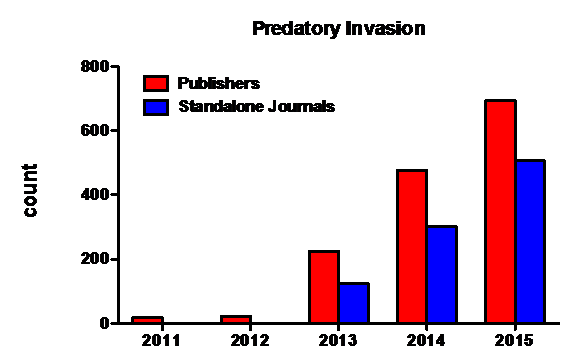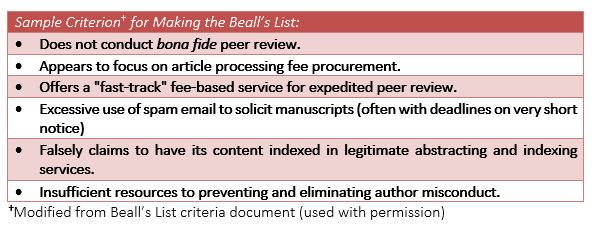By Michael Hughes, Research Associate in McNagny lab
The open-access publishing (OAP) model provides a mechanism for anyone with an Internet connection to freely access original research. Instead of locking research findings – work often funded by the public – behind subscription pay walls, the OAP relies on advertising and authors’ publication fees to remain profitable or, at least, break even. In many cases, OAPs simultaneously enjoy reduced publication costs by using an “online only” publication approach thereby avoiding the start-up, maintenance and overhead costs associated with a traditional brick-and-mortar publishing house.
The OAP era offers many benefits to the public and scientific community that currently outweighs the drawbacks. However, this critical balance is threatened by the proliferation of predatory publishers trying to take advantage of OAP for motives that are purely profit driven. There is nothing wrong with an OAP trying to make a profit – the problem comes when the desire for profit eclipses scientific integrity.

Figure 1. The proliferation of predatory publishers and journals (modified from Beall’s List data with permission)
Five years ago, there were maybe a handful of unscrupulous publishers and journals lurking about. Today, the publication waters are shark-infested (see Figure 1). This trend is making a mockery of the peer-review process and threatens the ability of scientists, but especially the layperson, to evaluate research quality. Predatory publishers have the potential to destroy the purpose of open-access research.
In this environment how will research scientists, especially less-seasoned graduate students and postdoctoral researchers, avoid becoming chum? To start, one can learn to recognize the tactics and unethical behaviours of predatory publishers. The predators are, so far, fairly easy to spot. That won’t last long – they are becoming stealthier. Sadly, abstracts of some suspect journals are even indexed in otherwise legitimate services. You can’t rely on a simple PubMed search to keep you safe.
Jeffrey Beall, an Associate Professor and academic librarian at the University of Colorado (Denver), serves as a critical watchdog for the open access authors by maintaining a curated list of “potential, possible, or probable predatory open-access publishers”. Beall’s List (https://scholarlyoa.com/)[*] includes publishers, stand-alone journals and even scientific conference organizers of which you should be wary. Essentially, predatory publishers and journals do not adhere to guidelines set out by the Committee of Publication Ethics (COPE). His criteria for listing suspect publishers and journals are available to download here. A few examples of these egregious practices are provided in Table 1.

You may also wish to follow Beall’s Facebook or Twitter to keep an eye on these questionable publication practices. He frequently offers great tips on how to avoid becoming a victim. For example, in a recent post[‡], Beall explains why you should be wary even while using PubMed and how to set up your searches to filter out the predators. If you are ever unsure about a publisher or journal, be sure to check Beall’s List before you dive in.
[*] Due to a quirk with WordPress pages, you’ll need to copy & paste this URL into your browser: https://scholarlyoa.com/
[‡] Paste this URL into your browser to view: https://scholarlyoa.com/2016/10/20/dont-use-pubmed-as-a-journal-whitelist/


